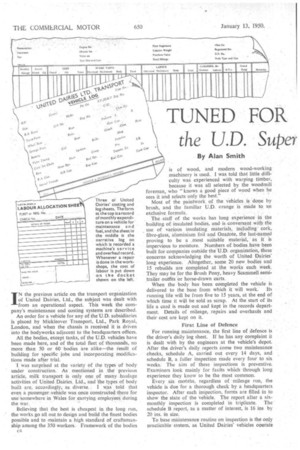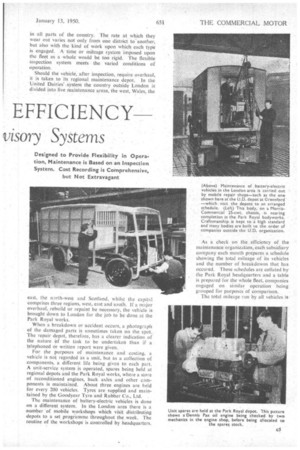TUNED FOR EFFICIENCY
Page 42

Page 43

Page 44

If you've noticed an error in this article please click here to report it so we can fix it.
the U.D. SUM
visory Systems
By Alan Smith IN the previous article on the transport organization of United Dairies, Ltd., the subject was dealt with from an operational aspect. This week the company's maintenance and costing systems are described.
An order for a vehicle for any of the U.D. subsidiaries is placed by Mickleover Transport, Ltd., Park Royal, London, and when the chassis is received it is driven into the bodyworks adjacent to the headquarters offices.
All the bodies, except tanks, of the U.D. vehicles have been made here, and of the total fleet of thousands, no more than 50 or 60 bodies are alike—the result of building for specific jobs and incorporating modifications made after trial.
I was surprised at the variety of the types of body under construction. As mentioned in the previous article, milk transport is only one of many haulage activities of United ,Dairies, Ltd., and the types of body built are, accordingly; as diverse.. I was told that even a passenger vehicle was once constructed .there for use somewhere in Wales for tarrying employees during
the war.
Believing that the best is cheapest in the long run, the works go all out to design and build the finest bodies possible and to maintain a high standard of craftsmanship among the 350 workers. Framework of the bodies is of wood, and modern wood-working machinery is used. I was told that little difficulty was experienced with warping timber, because it was all selected by the woodmill foreman, who "knows a good piece of wood when he sees it and selects only the best."
Most of the paintwork of the vehicles is done by brush, and the familiar U.D. orange is made to an exclusive formula.
. The staff of the works has long experience in the building of insulated bodies, and is conversant with the use of various insulating materials, including cork, fibre-glass, aluminium foil and Onazote, the last-named proving to be a most suitable material, as it is impervious to moisture. Numbers of bodies have been built for companies outside the.U.D. organization, these concerns acknowledging the worth of United Dairies' long experience. Altogether, some 20 new, bodies and 15 rebuilds are completed at the works each week. They may be for the Brush Pony, heavy Scarnmell semitrailer outfits or horse-drawn carts.
When the body has been completed the vehicle is delivered to the base from which it will work. Its running life will be from five to 15 years, at the end of which time it will be sold as scrap. At the start of its life a card is made out and kept in the records department. Details of mileage, repairs and overhauls and their cost are kept on it.
First Line of Defence For running maintenance, the first line of defence is the driver's daily log sheet. If he has any complaint it is dealt with by the engineers at the vehicle's depot. After the driver's daily reports come two maintenance checks, schedule A, carried out every 14 days, and schedule B, a fuller inspection made every four to six weeks. The aim of these inspections is preventive. Examiners took mainly for faults which through long experience they know to be the most common.
Every six mobths, regardless of mileage run, the vehicle is due for a thorough check by a headquarters inspector. After each inspection, forms are filled in to show the state of the vehicle. The report after a sixmonthly inspection is completed in triplicate. The schedule B report, as a matter of interest, is 16 ins by 20 ins, in size.
To base maintenance routine on inspection is the only practicable system, as United Dairies' vehicles operate
in all parts of the country. The rate at which they wear out varies notonly from one district to another, but also with the 'kind of work upon which each type is engaged. A time or mileage system imposed upon the fleet as a whole would be too rigid. The flexible inspection system meets the varied conditions of operation.
Should the vehicle, after inspection, require overhaul, it is taken to its regional maintenance depot. In the 'United Dairies'-system the country outside London is divided into five maintenance areas, the west, Wales, the east, the north-west and Scotland, whilst the capital comprises three regions. west, east and south. If a major overhatiljebuild or repaint be necessary, the vehicle is brought down to London for the job to be done.at the Park Royal works.
When a breakdown or accident occurs, a photograph of the damaged parts is sometimes taken on the spot.. The repair depot, therefore, has a clearer indication of the nature Of the task to be undertaken than if a . telephoned or written report were given.
For the purposes of maintenance and costing, a vehicle is not regarded as a unit, but as a collection of components, a different life being given to each part. A unit-service system is operated, spares being held at regional depots and the Park Royal works, where a store of reconditioned engines, back axles and other components is maintained. About three engines are held for every 200 vehicles. Tyres are supplied and maintained by the Goodyear Tyre and Rubber Co., Ltd.
The maintenance of battery-electric vehicles is done on a different system. In the London area there is a number of mobile workshops which visit distributing depots to a set programme throughout the week. The routine of the workshops is controlled by headquarters.
As a check on the efficiency of the maintenance organization, each subsidiary company each month prepares a schedule showing the total mileage of its vehicles and the number of breakdowns that has occured. These schedules are collated by the Park. Royal headquarters and a table is prepared for the whole fleet, companies engaged on similar. operation being grouped for purposes of comparison.
The total mileage run by all vehicles is given, together with the total number of breakdowns, and the average number of miles per breakdown for all vehicles is indicated at the foot of the table.
Each new table is printed side by side with the statistics for the previous month. I was shown one of the schedules and it revealed that whereas in May, 1949, there was one breakdown for every 14,000 miles, there was an improvement in June, when there was one breakdown for every 16,000 miles. Turning over the top sheet with the May and June figures, I found an attached slip on which the number of breakdowns was analysed, the number caused by electrical faults, engine, back axle and brake failures, tyre mishaps and other reasons being given.
A further check of costings is made in a compilation of statistics at Park Royal headquarters. Whenever a repair is made on a vehicle at a depot, a labour allocation docket and a material indent for stores are made out to show respective costs. Information from these is put on the vehicle's cost log, made up each month by the regional maintenance depot. On the number of labour dockets made out by the mechanic for each job he does in a day, his wages are assessed. The foreman marks each docket with a letter, appropriate to the type of repair, "E" for electrical, and so on.
A digest of each vehicle's maintenance cost figures is sent every month to headquarters, where a .omprehensive table showing the maintenance charges for every vehicle in the fleet, together with other information, such as mileage run and petrol consumed, is drawn
LIP every month. This provides a check, not only on the standard of maintenance, but also upon the performance and other characteristics of different types and makes of vehicle.
Should the table, for instance, show a heavy charge for maintenance on any particular machine and the reason is demanded, reference can be made to the cost sheet and narrative log. The log accompanies each vehicle to its depot and on it is written its service and overhaul record. If an abnormal number of_repairs to brakes be detected at headquarters, the records of machines of similar make are called in to ascertain whether this particular kind of failure is common to all such machines. If so, makers are consulted: if not, it points to a deficiency somewhere in the maintenance system—such as an incomplete job by a mechanic.
Records as Court Evidence Responsibility for faulty work can always be pinned down, which is most necessary in the case of accidents, and records have at times been produced as evidence in court. They show that the company sets out to maintain its vehicles to a high standard and that failures that lead to accidents are generally the responsibility of a particular person.
The amount of standing time for each vehicle is also shown on the headquarters tables. The object is to enable the merit of applications for additional vehicles by depots to be assessed. , In effect, transport headquarters acts as a Licensing Authority.
c6
In framing this recording system, it aimed, I was told, at providing only the really essential information. It was admitted that whilst the systems of other companies might be more complete, there was doubt Whether the practical use of masses of statistics was very great, especially as the employment of much. clerical labour was required. In any case, all detailed statistics can be readily obtained by headquarters if not held there. The U.D. system _avoids the passing of records of every minor item of expense and detail repair jobs to the next highest formation.
Checking Inspections
The individual vehicle records held at headquarters are made out at the beginning of the vehicle's service, and show, inter alia, the technical data regarding con. struction, mileage and standing time, and maintenance costs from month to month. When filed in the cabinet, a black runner that can be moved over a scale of numbers is obvious on each card. This indicates the number of six-monthly inspections the particular vehicle has had.
If the runner covers the figure " 2," for example, a reference to the date of that second overhaul shows whether the date when the third inspection is due has passed or not. If it has, the question why is asked.
This review of the costing and jecording system applies to all vehicles on all kinds of work. Naturally, milk transport is the most extensive of these, but other haulage carried out in connection With United Dairies' business is diverse, as has already been stated.
Many vehicles are employed on deliveries to the company's provision shops from stores and the docks. Bedford-Scammell 6-8-ton articulated outfits are used for this work. Similar vehicles are used for carrying eggs. United Dairies also has a number of bakeries, and Bedford and Austin 2-3-toriners are employed for carrying bread and cakes. Electric fork-lift trucks are in experimental service, and the internal distribution problem in many U.D. plants may be greatly eased by their use.
From the outlines of the United Dairies' operational, maintenance and costing systems given in these two articles, it can be seen that a large organization need not be inflexible. Indeed, with such a nationally important and personal function to perform, the company could not afford to work to a rigid, hide-bound system inevitably involving delaying red tape and " buck-passing." The planning of all activities shows that intelligent thought has been given to the evolution of methods which are relatively simple yet thorough, advanced yet practical.




































































































